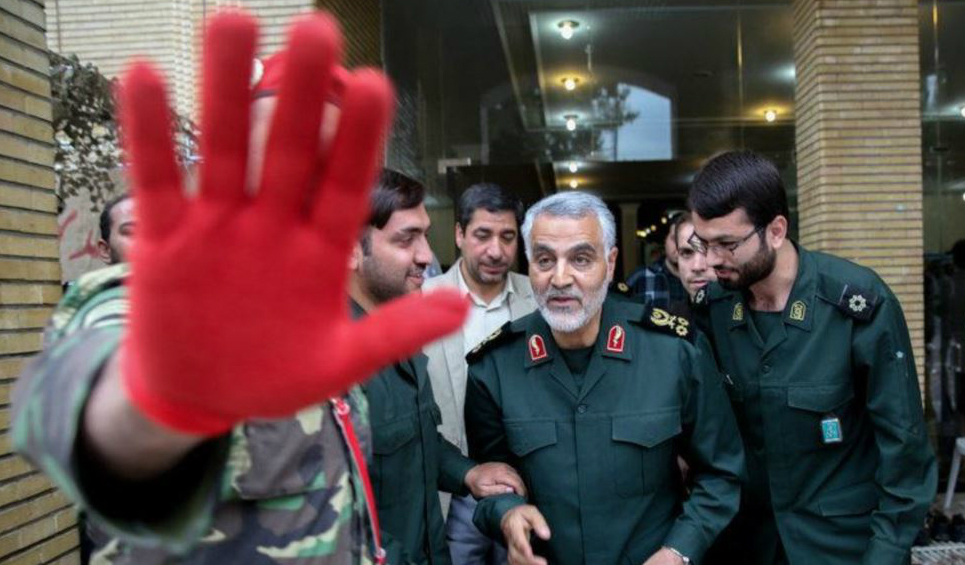Counteracting Iran’s Gray Zone Strategy in Syria
As the Islamic State continues to hemorrhage territory in Syria, Iran is extending its influence throughout the country as it works to establish a contiguous land corridor or “bridge” stretching from Tehran to Damascus and on to Beirut.

Published by The Lawfare Institute
in Cooperation With

As the Islamic State continues to hemorrhage territory in Syria, Iran is extending its influence throughout the country as it works to establish a contiguous land corridor or “bridge” stretching from Tehran to Damascus and on to Beirut. The situation in Syria is transitioning from an active conflict zone to what is known in military parlance as the “gray zone,” an area of ambiguity that sits uncomfortably between peace and war.
In addition to blurring lines, gray zone conflicts are characterized by confusion and uncertainty surrounding the nature of the belligerents involved, which in turn, make it more difficult to discern the appropriate policies and authorities that military forces and intelligence services are working under.
Most successful gray zone strategies are incremental and the resulting actions are designed to avoid being provocative, even when they are otherwise alarming. For example, Iran is quietly building a permanent military base in Syria, approximately eight miles south of Damascus. The conflict in Syria is entering a new phase, one in which the threat from the Islamic State has been severely attenuated, with large sections the country coming back under control of the Assad regime, even if the Syrian state still lacks the ability to actively govern these areas. In preparation for a post-conflict transition, Iran is working to help fill these security gaps by providing forces, training, and equipment.
Slowly building up the regime’s security infrastructure is one way to legitimize Iranian influence before the international community becomes further involved. Even though Syria will continue to suffer from low-scale violence well into the future, this will be relegated to predominantly Sunni areas that remain outside of Syrian government control. By the time world leaders can organize a peace deal for Syria, Iranian-backed power brokers will probably be firmly entrenched and recognized throughout most of the country where the Assad regime is able to reassert control. Parts of the country, especially northwest Syria, are still host to Salafi-jihadist groups, to include al-Qaeda elements, which will continue to be a constant challenge for Iran. Through deception and misdirection, Iran will likely continue to rely on hybrid organizations like Hezbollah as part of its growing strike force, which also includes the legion of Shiite foreign fighters that Tehran has been recruiting, training, and deploying in Syria for several years.
In areas in Syria where the Islamic State has withdrawn or been defeated, the United States has been competing with Iran to secure these newly liberated territories. Through more active involvement in Syria, it seems inevitable that forces linked to or supported by Iran will come into direct contact with the U.S. military, as they did in southeast Syria in early June when U.S. forces struck Iranian-backed militias on multiple occasions near the Syrian border post al-Tanf. Part of Iran’s gray zone strategy is working to minimize these types of incidents and keeping its interactions with the United States in Syria relegated to operations below armed conflict. As my RAND colleague and noted gray zone expert Michael Mazarr has observed, “Iranian strategic tradition recommends indirection and avoiding unnecessarily decisive fights where possible.”
Iran’s efforts in the gray zone are largely directed toward its ongoing struggle with Saudi Arabia, in which Tehran supports Shiite populations in Iraq, Yemen, Lebanon, Syria, Bahrain, and elsewhere. Yet Iran seems to work tirelessly to disguise its true intentions, working instead through the Islamic Revolutionary Guards Corps, an elite military unit used by the regime to train proxy forces abroad as a means of extending Iranian foreign and security policy throughout the Middle East. Iran rarely confronts its adversaries directly and instead prefers to rely on information operations, covert action, and unconventional warfare, all of which are intended to offset its lack of conventional military capabilities.
But since the United States is not actually at war with Iran, much of Iran’s gray zone activities have continued unabated, in part because the United States is already committed in several other theatres simultaneously. The nature of warfare is constantly evolving, and clearly defined notions of war and peace have become outdated. As current National Security Council staffer Nadia Schadlow once noted, the gray zone is not a place lacking action but “a landscape churning with political, economic, and security competitions that require constant attention.” As the Islamic State is further weakened in Syria, the United States is rightly concerned that Islamic Revolutionary Guards Corps forces and their affiliates may very well fill the power vacuum left behind.
Still, there is a way for the United States to push back against Iran’s gray zone strategy in Syria. Iran’s actions throughout the region have been perceived, at times, as unnecessary meddling by the domestic populations of Gaza, Lebanon, Yemen, and Iraq, further attenuating Iran’s ability to influence events on the ground. Moreover, Iran has squandered significant blood and treasure in Syria in its quest to prop up Assad, a brutal dictator guilty of slaughtering his own people.
The United States might seek to use these missteps as leverage to pressure Iran. As Georgetown professor Daniel Byman recently noted, the United States could “constantly highlight the cost of Iran’s adventurism in Yemen and support for the Syrian regime to increase popular disgruntlement regarding the regime’s foreign policy.” The longer the Syrian civil war rages, the more coffins will return to Iran, leading the population to question the military’s involvement in civil war in an Arab country. The recent Iranian protests provide some proof of this—just recently, in demonstrations in the city of Mashhad, typically considered a regime stronghold, protesters shouted, “Leave Syria alone, think about us.”
The concept of gray zone warfare is not new, but the United States still lacks a clear and coherent strategy to respond to actions undertaken by nation-states and their proxy forces that fall short of conflict. Countries like Russia, China, and Iran are aware of this and, accordingly, will continue to operate around the edges, pushing up close to the boundary but attempting to stop just short of provoking the United States.
To counter Iranian efforts in the gray zone, and the inevitable actions of other countries in a similar manner, the United States should dedicate significant resources to crafting its own gray zone strategy that would prevent Tehran from taking advantage of the current conflict and humanitarian crisis and instead impose limits and restrictions on Iranian efforts to cement its influence in Syria and indeed throughout the broader region.




